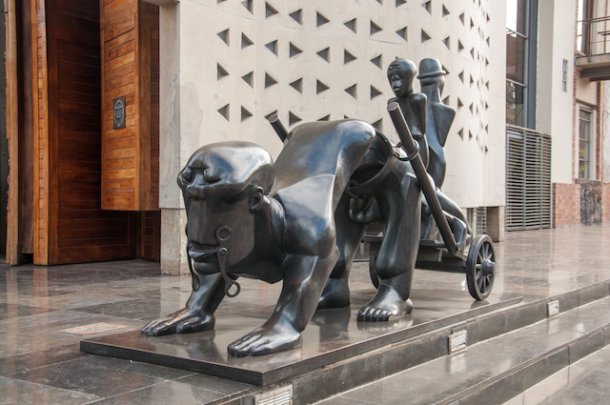A colecção de arte do Tribunal Constitucional de Joanesburgo
Publicado29 Jan 2015

Imagem: Dumile Feni. “History” 2003, bronze. Foto de Akona Kenqu
O Tribunal Constitucional de Joanesburgo alberga uma colecção de arte (Constitutional Court Art Collection-CCAC), que pretende ser uma homenagem aos ideais pós-apartheid inscritos na constituição. O site Contemporary and traça o perfil e a evolução da colecção e entrevista os juízes que acompanharam esse processo.
The state of the collection mirrors the troubles faced by South Africa as a country. After a period of exuberance in the years following an astonishing transition to a legal order that protects the rights of all people, the hard and grinding work of maintaining a successful democracy has set in. The success of South Africa’s new constitution will be determined not only by the strength of the judgments coming from South Africa’s courts, but also by the efforts across all of the country’s civil society to promote respect for the human rights of its people.
CCAC symbolises the best aspirations of our democracy, of reconciliation, of justice, and of transformation… when we’re fighting for the artworks, we are also fighting for the underlying project of making a viable democracy in South Africa. To this end, the importance of the CCAC is not only to infuse the judgments of the court with empathy, but to provoke debate and reflection across a broader swathe of South African society. As the American jurist Learned Hand said: “I often wonder whether we do not rest our hopes too much upon constitutions, upon laws and upon courts. These are false hopes, believe me, these are false hopes. Liberty lies in the hearts of men and women, when it dies there, no constitution, no law, no court can save it, and no court can even do much to help it. While it lies there it needs no constitution, no law, and no court to save it.”
CCAC does not rest its hopes solely on the jurisprudence of the institution whose building it shares. It promotes the ideals of South Africa’s constitution in a way that both overlaps and is independent of the law through a series of enigmatic and essential messages. Memorials lie everywhere. The struggle continues. We carry each other. CCAC represents a history of intense passion, pain and redemption. And as it reflects on that history, it challenges and inspires a history that has yet to be written.
C&: What are the motivations behind the Constitutional Court Art Collection (CCAC) of South Africa?
Albie Sachs & Edwin Cameron: CCAC began when Justices Albie Sachs and Yvonne Mokgoro chose to use the Constitutional Court’s small decor budget of about $1,000 USD to commission a tapestry from Joseph Ndlovu. Titled Humanity, this tapestry is perhaps a wish for the future of a country, which has been so deeply divided by the trauma of its history. The artwork features several people huddling together. All of them have their eyes closed, unable to judge gender, race, or age, and in this way uniting them in their humanity.
In many ways this artwork is a departure from the Greco-Roman personification of Justice as a blindfolded goddess balancing the scales. Used as the symbol of the rule of law all over the world, Lady Justice seems to imply a universal concept of what is just. Her blindness too suggests impartiality, but perhaps when justice chooses to be blind, she’s not as welcoming to those seeking her most urgently. In Humanity, the mirrored action of people closing their eyes seems markedly different: a coming together of communities to consider justice through empathy and togetherness. It is a working concept of justice that is determined by a multiplicity of voices.
Similarly, the logo of the court, designed by artist Carolyn Parton, departs from the symbol of Lady Justice by featuring a group of 11 people gathered beneath a tree. The 11 people represent the 11 official languages in South Africa, which indicates how all citizens of the country are sheltered by the constitution and the rule of law. But, importantly, the figures are not merely sheltered: they actively hold up the branches of the tree.
CCAC has grown out of the purchase of Humanity to include over 400 pieces by artists from all over the world. As an expression of justice, human rights, and reconciliation, the installation of this art collection provides a multiplicity of voices to participate in the way we imagine the future of the country and, perhaps more importantly, engender empathy and unity. Most court buildings, if they have images in them at all, have pictures of dead white male judges. One day both of us will be dead white male judges. There is nothing wrong with that, but if those are the only images, they say that only men mattered and only whites mattered.
A entrevista integral, na Contemporary and
